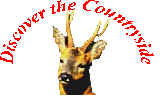
Discover The Countryside !

The Fascinating World Around Us -
An Introduction to British Wildlife and Habitats, for
16 - 22 year olds.
LIST OF ACTIVITIES - CONTINUED
| Activity | Outline | ||
|
This activity highlights the
incredible complexity of ecosystems which is a result of the innumerable microhabitats
contained within them. It will investigate the enormous variety of life to be found in different microhabitats within a woodland, although any habitat could be looked at, within reason. Woodlands make a good choice because of the enormous variety of easily accessible microhabitats.
Look at collembolans in soil, millipedes in leaf litter, slugs on fungal fruiting bodies, beetle larvae in rotting wood, mites in mosses, mosquito larvae in tree pools, caterpillars in the tree canopy, leaf miners in leaves, gall wasps in plant galls and many more besides. |
||
|
Biodiversity doesn't only exist in rain forests,
Britain has its own fair share. It is all around us if we only know how to look.
A look at the amazing creatures under our noses which we usually fail to see. This will involve a comparative look at some of the fascinating array of creatures and plants to be found in our own local habitats, from diatoms to ducks. |
||
|
This activity will look at the practicalities of conservation and management,
with the benefit of the experience gained from restoring the Centre's own habitats. Topics covered will include:
|
||
|
This activity will look at human influences on freshwater habitats from
pollution, to management for maximum wildlife benefit. The following topics will be
covered:
|
||
|
How do you know what is
there? How do you compare different habitats? What sort of methods would you use to sample
different kinds of animals? Why do we need to sample? All of these questions and many more will be answered. The students will practice using various different techniques and methods of biological sampling. Find out the working practicalities of each method, rather than the text book version! Try such techniques as:
Students will benefit greatly from the wealth of data and information freely available on many of the Centre's habitats and species. |
||
|
Get an
entirely different perspective on the countryside and view it as few people see it. Visit
the Centre at night when the atmosphere changes completely. Nothing looks the same in the
dark. Creatures that we are often totally unaware even exist, come out of hiding under the
cover of darkness. Put out the moth trap in different habitats and see the difference in the variety of insects drawn to the light. Use a bat detector to track down different kinds of bats. The Centre is an important amphibian breeding site. Visit in March and see hundreds of Toads and search for palmate newts. Badger watch in the summer. These activities will provide innumerable examples of species which can be used to explain a wide range of environmental principles. |